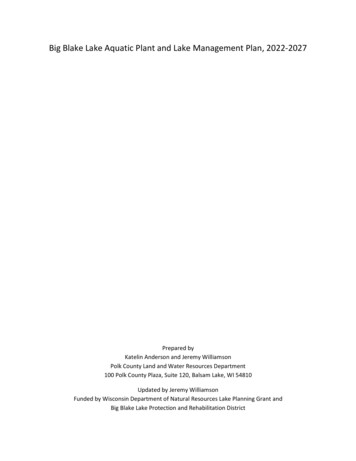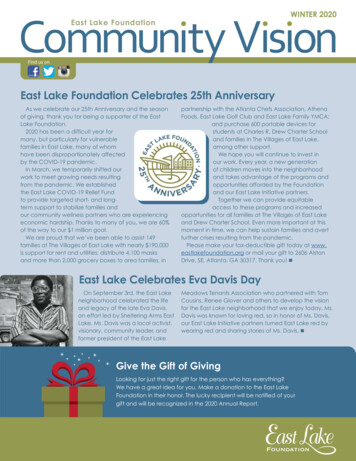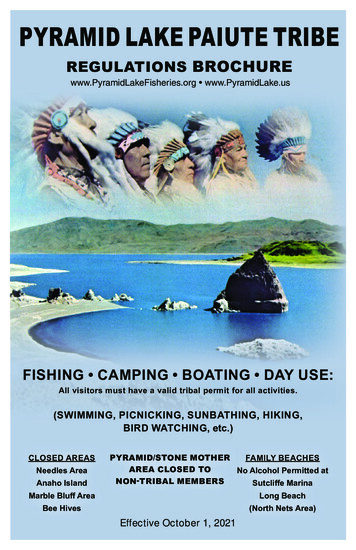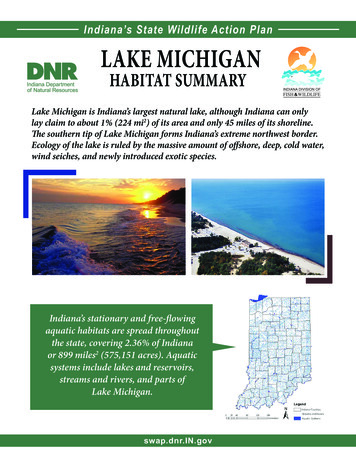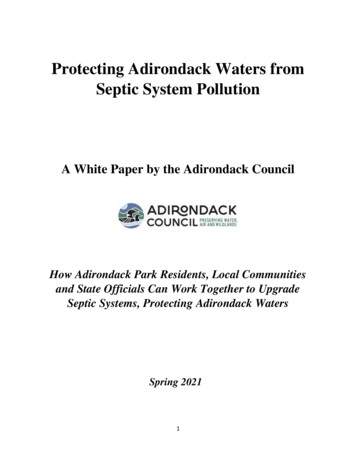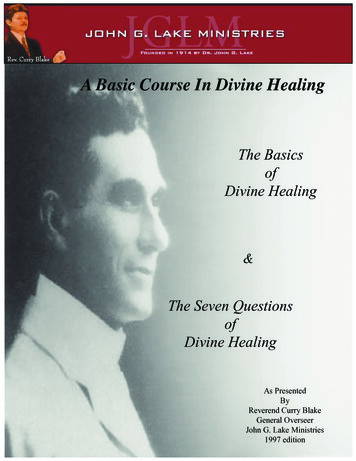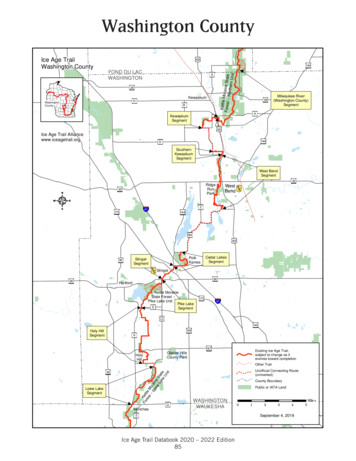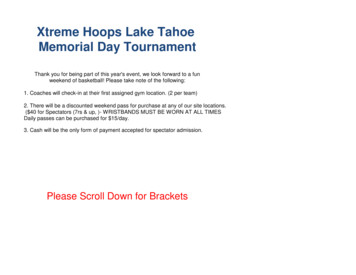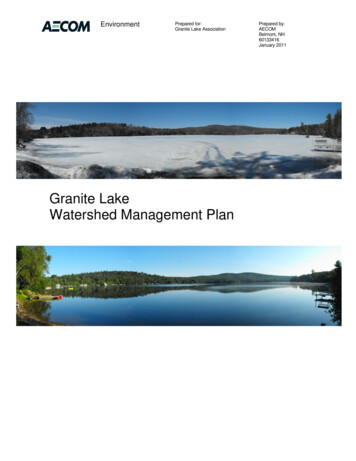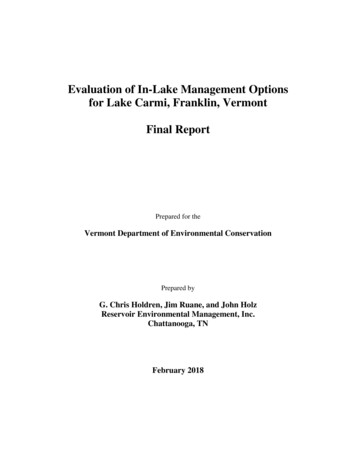
Transcription
Evaluation of In-Lake Management Optionsfor Lake Carmi, Franklin, VermontFinal ReportPrepared for theVermont Department of Environmental ConservationPrepared byG. Chris Holdren, Jim Ruane, and John HolzReservoir Environmental Management, Inc.Chattanooga, TNFebruary 2018
Table of Contents1.0 Introduction . 12.0 Restoration Methods Under Consideration . 32.1 Diffused Air Circulation . 52.2 Updraft Pumping . 52.3 Downdraft Pumping . 72.4 Downflow Bubble Contact . 82.5 Sidestream Supersaturation . 92.6 Alum Treatment . 92.7 Cost Summary . 103.0 Evaluation of Listed Alternatives . 124.0 Recommendations . 145.0 Additional Considerations . 156.0 References. 17List of Figures and TablesFigure 1 Proposed diffuser line deployment in Lake Carmi . 6Table 1 – Estimated costs for various restoration methods . 11
1.0 IntroductionLake Carmi is a large (surface area 1,402 acres) and relatively shallow lake (maximum depth 33 ft) located in the Town of Franklin, Vermont. The lake is heavily used for recreation,including fishing, boating, and swimming. Lake Carmi has a long history of water qualityproblems related to high phosphorus loading. Problems include late summer algal blooms, poorwater clarity, and heavy aquatic plant growth. As a result of those problems, the VermontDepartment of Environmental Conservation (VTDEC) listed the lake as impaired by highphosphorus concentrations under Section 303(d) of the Clean Water Act. This led to preparationof a Total Maximum Daily Load (TMDL) analysis by the Vermont Agency of Natural Resources(VTANR, 2008).Lake Carmi has a watershed area of 7,710 acres. A land use analysis conducted as part of theTMDL (VTANR, 2008) indicated the major land uses in the watershed were wooded areas andwetlands (45%) and tilled or untilled farm land (44%). Intensive shoreline development and lowdensity residential development spread throughout the watershed comprised the remainder of theland use. The TMDL used export coefficients based on land use to estimate P loading throughrunoff from the watershed at 1,333 kg/yr, with an additional 88 kg/yr contributed by directprecipitation on the lake surface. Separate estimates were made for internal P loading (97 kg/yr),P loading from septic systems (15 kg/yr), and the Lake Carmi State Park wastewater treatmentfacility (1.5 kg/yr). The modeling effort relied on the Wisconsin Inland Lakes Modeling Suite(WILMS). WILMS (WIDNR, 2001) uses a number of common, published lake phosphorus modelsto estimate in-lake phosphorus concentrations from loads.As a result of concerns over algal blooms, the Franklin Watershed Committee was formed in1994 (originally as the Carmi Watershed Committee) to investigate and address sources ofphosphorus to Lake Carmi. The committee initiated several projects to improve water quality,including some that addressed specific issues noted in the TMDL analysis. These included anIntegrated Crop Management assessment that focused on nutrient needs and manuremanagement of crop and hay fields for three farms in the watershed. Other projects included aseptic tank pumping cost share and a septic survey to understand the relative suitability ofexisting septic systems and the extent to which camp owners knew about their septic systems andhow to take care of them. Stream assessments, shoreline stabilization projects, and a laymonitoring program that collected data on Lake Carmi since prior to 1980 were also conducted.The nutrient reductions recommended by the Lake Carmi TMDL will take several years to befully implemented. In the meantime, the observed water quality problems are continuing andthere is growing concern over the nuisance algal blooms. As a result, the Vermont DEC fundedthe current study to investigate in-lake methods that can potentially reduce internal phosphorusloading and reduce algal blooms.In-lake restoration measures are aimed at enhancing the viability of lakes by alleviating specificsymptoms of eutrophication. These restoration measures may provide short-term relief toexisting water quality problems because, while they provide limited control for nutrients andother pollutants, they can substantially improve the aesthetic and recreational potential of the1
lake and help gain public support for the restoration program while long-term managementpractices are being implemented.Wagner (2001) listed 18 potential in-lake management options, but those methods vary widely incost, effectiveness in addressing various water quality problems, effects on other lake uses, andpotential side effects. For example, chemical treatments can control nuisance algal growth but donot reduce nutrient concentrations and may have adverse long-term effects on other aquaticorganisms. In contrast, dredging may reduce internal nutrient loading if enough nutrient richsediments can be removed, but it is expensive and is unlikely to control algal growth as long assignificant external nutrient loading is occurring.Reservoir Environmental Management, Inc. (REMI) evaluated existing water quality data fromLake Carmi to determine the type of in-lake treatment that has the greatest probability of bothimproving lake water quality by controlling internal phosphorus loading and reducing orcontrolling the problems associated with nuisance cyanobacterial blooms. The various types ofaeration/oxygenation systems that are available, as well as alum treatment, were the restorationmethods evaluated.2
2.0 Restoration Methods Under ConsiderationThree main methods restoration methods were considered for Lake Carmi, and they arediscussed in detail below: Artificial circulation Hypolimnetic aeration/oxygenation Phosphorus binding with aluminum (alum treatments)A recent review of aeration/oxygenation systems used in water treatment reservoirs (Wagner,2015) identified seven basic methods for increasing oxygen concentrations in lakes andreservoirs. The typical goal of aeration/oxygenation methods is reducing internal loading ofphosphorus and other nuisance parameters, including ammonia, iron, manganese, and hydrogensulfide, by increasing dissolved oxygen concentrations in the water column. In addition, some ofthese methods have also shown the ability to reduce nuisance blooms of cyanobacteria.There are three basic artificial circulation methods:1) direct release of diffused air into the water column at a rate sufficient to mix the watercolumn,2) updraft pumping systems, and3) downdraft pumping systems.The primary objectives of an artificial circulation system are to completely mix the water columnand increase dissolved oxygen concentrations. Increasing oxygen levels oxidizes iron andmanganese to convert them from soluble to insoluble forms, which also helps bind sedimentphosphorus. Oxidation also converts ammonia to nitrate and sulfide to sulfate. In addition,mixing the water column may reduce algal growth.Several different methods have been proposed for controlling algae and cyanobacteria throughartificial circulation (Lorenzen and Fast, 1977; Pastorak et al., 1981; Cooke et al. 2005; Wagner;2015). Mixing increases the mixed depth to reduce algal growth through light limitation Mixing also interferes with growth by subjecting algae to turbulence and rapid changes inhydrostatic pressure Mixing may reduce internal nutrient loading by eliminating the anaerobic conditions thatfavor phosphorus release.Reductions in concentrations of cyanobacteria are common, even in those cases when there wasan overall increase in algal biomass. Potential explanations for the control of cyanobacteriainclude: Increased circulation eliminates the competitive advantage that cyanobacteria have bybeing able to use buoyancy to reach optimum light levels.Dominance by cyanobacteria is favored by high pH and low levels of free carbondioxide, but complete circulation usually results in a decrease in surface pH and increasesin carbon dioxide as surface and bottom waters are mixed3
Algal sinking rates are reduced with increased mixing, favoring heavier algal species thatdo not have buoyancy adaptationsMixing can also increase concentrations of both oxidized (nitrate) and reduced(ammonia) forms of nitrogen in the epilimnion by mixing surface and bottom waters.This can eliminate the advantage that cyanobacteria gain by being able to fix atmosphericN2 under low nutrient conditions.In addition to the artificial circulation methods, there are four types of hypolimneticaeration/oxygenation systems that increase oxygen levels in the bottom layers of a lake withoutmixing the water column. These include:4) direct release of oxygen gas at the bottom of the water column (typically through poroushose),5) hypolimnetic aeration, which releases air into submerged chambers and transfers oxygento the water as the bubbles rise,6) downdraft bubble contact, which injects oxygen into water being pumped downward in achamber, with most of the oxygen being absorbed by the water before it is released intothe target zone of water depth, and7) sidestream supersaturation, which adds oxygen to a shore-based pressurized chamber toproduce a super-saturated solution that is released to the target zone.Hypolimnetic aeration systems are designed to maintain stratification in the water column andincrease dissolved oxygen concentrations in the lake’s hypolimnion, with maintenance of a coldwater fishery often being one of the goals. Hypolimnetic aeration systems are usually expensiveto install and maintain and are more suited to deep lakes with relatively large hypolimnia.Alum treatment was also considered because it has been demonstrated to control internalphosphorus loading and to reduce the water column concentration of phosphorus. Alum is highlyeffective at binding (inactivating) phosphorus and making it unusable for algal growth.Different application strategies are used to sequester P in the lakebed sediments (internal loadingcontrol) and/or to strip P from the water column. The best strategy (e.g., full dose, split dose,annual low dose) is dependent on the sources and timing of the lake’s P loads. In a recent reviewof full dose alum treatments, Huser et al. (2016), reported that the water quality benefits of thealum application lasted an average of 21 years in lakes throughout the world.Preliminary cost estimates were obtained for the following restoration methods:1) Circulation- Diffused air circulation (Mobley Engineering)- Updraft pumping (Medora Corporation - Solar Bee)- Downdraft pumping (WEARS)2) Aeration/Oxygenation- Downflow bubble contact (Eco2 - Speece Cone)- Sidestream supersaturation (BlueInGreen)3) Alum treatment (HAB Aquatics)4
No cost estimates were requested for direct release of oxygen gas at the bottom of the watercolumn (typically through porous hose) or for hypolimnetic aeration. Lake Carmi is too shallowfor either of these methods to work effectively, and diffused air circulation through a porous hosesystem would be more effective and less costly in solving the observed water quality problemsthan direct release of oxygen through a similar system.The cost estimates below are subject to revision; actual costs cannot be determined until a finalengineering assessment is completed. The estimates below were based on preliminaryinformation from the listed vendors and stated assumptions. The estimates were based, in part,on areas and volumes calculated by REMI from the available bathymetric map. A more accurateassessment of the areas and volumes at various depths in Lake Carmi is required for final design.2.1 Diffused Air CirculationA preliminary analysis of a diffused air circulation system was performed by applying a bubbleplume model to develop an approximate design capacity that could circulate Lake Carmi. Thesesystems are comprised of porous hose similar to the hose sold locally for irrigating gardens andlandscaping around homes and commercial buildings. For aeration applications the hose is usedto act as a diffuser that can release small air or oxygen bubbles into a lake water column so thatdissolved oxygen can be added to the water and the water column can be mixed to the desiredextent. To circulate a lake, air is distributed through a site-specific designed system of poroushose to optimize the lake mixing effectiveness. Lake Carmi water quality data were reviewed todevelop a preliminary design to provide the basis for a preliminary cost estimate. The purpose ofthe design was to add dissolved oxygen to the water as well as circulate the lake to reducecyanobacteria and enhance opportunity to replace these growths with more desirable algae.The developer of the porous hose diffuser system, Mobley Engineering, Inc., developed apreliminary design for Lake Carmi. He came up with a system comprised of about 5,400 feet ofdiffuser (40 active 90 foot diffuser sections) with 600 cfm (150 HP) to break through thermalstratification. About 200 cfm would be sufficient to keep it mixed once destratified. The diffuserdeployment at Lake Carmi would likely be as shown in Figure 1.Mobley’s cost estimate was 633,536 for the diffuser installation and 886,160 for the air supplyfacility installation, with both cost figures including contingencies at 25%. Annual O&M costsfor the diffused air circulation system are expected to be about 75,000 for compressor operationbased on a cost for electricity of 0.15/kWh and 1,500 for compressor maintenance. Asoperation of the diffuser system gets underway, lake data collection over a period of time couldallow developing an operational procedure that could reduce these power costs. For example,DEC might find that 1) the aeration period can be reduced, and 2) both compressors are notrequired under certain conditions.2.2 Updraft PumpingCost estimates were obtained from Medora for the installation of their Solar Bee pumps in LakeCarmi. Because each Solar Bee is designed to treat a maximum of about 35 acres, an estimated20 units would be required to treat Lake Carmi. Each unit costs approximately 45,000 and5
comes with a 2-year warranty. Volume discounts for the units would be likely based on the largenumber expected to be required. Operation and Maintenance are handled through servicecontracts from Medora, which include two visits per year and are estimated at 2,580/unit/year.In addition, monthly cleaning of the solar panels by local personnel would probably be required.Figure 1 – Proposed diffuser line deployment in Lake Carmi.6
Solar Bee costs were based on the assumption that 20 units would be required. Medorarecommended that the units should be placed around the lake perimeter for optimum algalcontrol. Note that this would not control internal phosphorus loadingSolar Bee Cost SummaryCapital cost: 20 units x 45,000 900,000Annual O&M cost: 20 units x 2,580 51,600Note: Additional costs for local personnel will also be required to clean solar panels.2.3 Downdraft PumpingA cost estimate for downdraft pumping was received from WEARS Australia. This is apreliminary estimate based on the following caveats. Site inspection has not been completed, so access to site, electricity (availability andlocation), proximity to services, etc. are assumed as being standard. Pricing was supplied by WEARS based on a standard installation. No allowances weremade for the inclusion of third parties or having to manage other trades or servicesthroughout.Assumes power cable to be laid by others to WEARS specifications on time and in full. Assumes one trip to USA for up to 2 weeks for a WEARS crew to complete/superviseinstallation. No allowance was made for return trip/s or delays. Assumes smooth transition through contract and installation processes. No allowance has been made for permits, charges, fees or other state, local or federalcharges in Vermont. Assumes that the State will provide an appropriately sized and secured build and setdown site at a location nominated by WEARS. No allowance has been made for crane hire, USA assembly crew or contractor (ifrequired) or other local requirements, such as planting, tools, etc. Once more information is known, the above can be either priced, eliminated, or otherwiseagreed on. WEARS can complete all of the excluded items and they can be pricedaccordingly, if required.Based on the information provided, the best solution for Lake Carmi will be installation of aResMix 3000CC. The ResMix 3000CC is a specifically designed application of two ResMix3000 systems in a ‘Close Coupled’ arrangement. This system is used for lakes and reservoirswhere flow requirements are high, but where depth prevents the use of a larger system such asthe ResMix 5000. The systems are connected via a footbridge that allows transit between the twounits for servicing, etc., with ease.7
Although it may not be necessary (depending on modeling results), a ResMix 1000 system couldbe installed in the northeast part of the lake to provide additional mixing for more immediatecontrol of algal blooms, if the budget allows. The ResMix 1000 system would provide anadditional mixing capacity of 9,800 gal/min (37,300 L/min) for only 3HP (2.2kW). This wouldbe additional targeted flow for a more rapid localized effect.Capital costs include a ResMix 3000CC system, including foot bridge, electrical control panelincluding variable speed drives, and full SCADA compatibility; installation supervision byWEARS, including crew, travel, accommodations, and meals (up to 2 weeks); and internationalfreight for shipping from Australia to USA and road transport from the nearest port. The totalcost for a fully engineered solution, installation report, and Operations and Maintenance manualwould be 424,700.Each unit will be fitted with a very efficient 2.2 kW (3 HP) motor and gearbox. The ResMix3000 system is able to achieve required flow and pumping velocity without high power needs.Operational costs assume that each unit draws approximately 1.6 kW for 24 hours per day, 365days per year. Assuming an average annual cost of 0.15/kWh for electric power. The cost foreach unit operated would be approximately 14,000/unit/year, or 28,000/year for the ResMix3000 Closed Couple system. The ResMix 1000 system also uses a 2.2 kW motor, resulting in anadditional operating cost of 14,000/year.The cost for the ResMix 1000 system, including the same factors as the ResMix 3000CC system,would be 114,900. Some savings on shipping and installation costs could be realized if theResMix 1000 system was ordered and installed at the same time as the ResMix 3000CC systemsGenerally the systems require a visual inspection twice per year, which can be easily completedby the operator, and a mechanical service once each year. The mechanical service includes thechanging of the food grade oil, greasing coupling and bearing, checking all connections (underand above water) and general cleaning and maintenance. WEARS completes this work in theirdomestic market relatively cheaply ( 3,500 per year), and generally without issue. Similar costswould be expected here.The WEARS systems are designed to operate in excess of 20 years. WEARS suggests a refitafter 10 years to replace barrier netting, entry cone panels and draft tubes, and perform anyupgrades, etc. WEARS carries spare parts for all components and provides ongoing support, asrequired.2.4 Downflow Bubble ContactA cost estimate for installing a Speece Cone at Lake Carmi was provided by Eco2. Costs werebased on treating the hypolimnetic volume of 470 acre-ft, which was calculated to require 3,536pounds of oxygen per day. The cost for the Eco2 system, which includes a 10-ft diameterstainless steel cone with a life expectancy of 20 years, and an 84-hp (5,400 gallon/minute) pumpis 480,000 for the basic system and 100,000 for the pump.Operating costs will depend upon whether the liquid oxygen (LOX) is purchased locally orgenerated by on on-site oxygen generator. If the LOX is purchased locally, the gas suppliertypically maintains the LOX tank and related equipment. Annual O&M cost for that option are8
estimated at 27,100 for pumping, 5,420 for pump maintenance, 29,000 for LOX, and 12,000for the equipment lease.The on-site LOX generator has an estimated cost of 250,000, but oxygen would be produced ondemand and the other costs would be reduced. After the initial outlay, annual O&M costs areestimated at 27,100 for pumping, 12,800 for oxygen, and 8,000 for maintenance.Eco2 Cost SummaryCapital Cost: 480,000 for Eco2 system 100,000 for pump 250,000 for on-site LOXgenerator (optional)Annual O&M cost: 73,520 for pumping, maintenance, and LOX purchased from local vendoror 47,900 with the on-site LOX generator2.5 Sidestream SupersaturationA cost estimate for sidestream supersaturation (SSS) was received from BlueInGreen, The costestimate for the SSS system assumed a typical design point for sediment oxygen demand of 1 gO2/m2/day (a typical range is 0.5 – 3 g O2/m2/day). BlueInGreen can provide a basic unit (withO2 supplied by others, either as LOX or generated on-site) for about 300,000 to 350,000delivered to site with start-up assistance. A completely containerized injection system could besupplied, if requested, which would simplify installation considerably. Installation and sitepreparation costs were not included in the estimate received.BlueInGreen also has a lease option that includes service and support if the client would prefernot to own the equipment. Contracts for the lease option are typically provided on a yearly basis(1-year minimum) and are typically about 20,000/month, not including oxygen costs. Lowerprices could be available for longer term commitments.For a system of this size, BlueInGreen recommended using LOX. The LOX requirement wasestimated to be 10,000 to 12,000 lb O2/day through the BlueInGreen dissolution and injectionsystem. This would result in yearly pumping costs of 256,100 (230hp @ 0.17/kWh) and anannual LOX cost of 228,860 at maximum flow (12,000 lb/day).BlueInGreen Cost SummaryCapital Cost: 300,000-350,000 for a basic system. Potential additional costs were not itemized.Annual O&M cost: 484,960 at maximum flow.2.6 Alum TreatmentThe historic annual hypolimnion total phosphorus increase during summer oxygen reduction andthe TMDL external and internal loads were reviewed. Assuming an annual internal load of 560lbs/yr, a dose of 168,000 lbs of aluminum was calculated for a full dose application. This dosewould be applied to areas of the lake with depths 20 ft in the form of a buffered alumapplication due to the low alkalinity of Lake Carmi. Alum and the buffer (sodium aluminate)would be applied a ratio of 2 gallons alum-to-1 gallon buffer. The estimated cost for thisapplication is 660,000. We recommend that the concentration of available phosphorus in the9
lake sediments be determined to confirm the alum dose. There are no annual O&M costsassociated with an alum application.A second alum application strategy could also be implemented. Instead of the traditional, fulldose application, annual low dose applications are conducted to inactivate phosphorus in thewater column. The annual dose would be designed to inactivate approximately 611 kg ofphosphorus. This is equal to the required annual load reduction reported in the Lake CarmiTMDL. The annual cost of this application strategy would be approximately 150,000 to 160,000/yr. A benefit of this strategy is that it immediately meets the annual TMDL loadreduction as long-term watershed work to control external phosphorus sources are ongoing. Theannual application dose could be lowered (or stopped) once the external load controls wererealized.2.7 Cost SummaryCosts for the six methods described above are summarized in Table 1. Note that costs fordiffused air circulation included costs for site preparation and other engineering costs that werenot included in the estimates for the other five methods. In addition, all of these costs arepreliminary estimates only and may be expected to change as more information becomesavailable.10
Table 1 – Estimated costs for various restoration methodsRestoration MethodDiffused aircirculationCapital Costs 633,536 for diffuser installation 886,160 for air supply facility installationUpdraft pumping20 units x 45,000 900,000Downdraft pumping 424,700 for a ResMix 3000CC, includingshipping and installation supervision.Downflow bubblecontactSidestreamSupersaturationAnnual O&M Cost 75,000 forcompressor operation 1,500 for compressormaintenanceMaintenance contract- 20 units x 2,580 51,600 28,000 electrical cost 3,500 for mechanicalservice 114,900 for an optional ResMix 1000system for the northeast corner of the lake,including shipping and installationsupervision 480,000 for Eco2 system 100,000 for pump 14,000 electrical cost 3,500 for mechanicalservice 250,000 for on-site LOX generator(optional) 47,900 with theoptional LOXgenerator 256,100 yearlypumping costs 300,000-350,000 for a basic system.Additional costs for pumps and othersystem components may be required. 73,520 for pumping,maintenance,equipment lease, andLOX purchased froma local vendor 228,860 annual costfor LOX at maximumflowAlum treatment (fulldose) 660,000 for application of 168,000 lbs ofaluminum 0Alum treatment(annual, low dose) 150,000 to 160,000 per year 0 other thanapplication costPlease note that the costs listed in Table 1 are not directly comparable. The costs for diffused aircirculation are the most complete because they include engineering fees for site preparation,testing, and other fees, plus they provide additional costs for contingencies and eventual diffuserreplacement. None of the other estimates included these costs, which are not insignificant.11
3.0 Evaluation of Listed AlternativesThe treatment alternatives listed above were evaluated both on their ability to reduce phosphorusloadings to Lake Carmi and on their ability to potentially control nuisance blooms ofcyanobacteria; however, phosphorus loading does not appear to be a significant factor indeciding on the most appropriate treatment method. All of the aeration/oxygenation methodswould reduce internal loading by oxidizing iron in the hypolimnion and immobilizingphosphorus. Alum treatment would be even more effective in binding phosphorus, but the LakeCarmi TMDL (Vermont ANR, 2008) estimated internal P loading as 97 kg/yr, which is only 6%of the total calculated P load of 1,595 kg/yr. The TMDL further calculated that a reduction in Ploading of 611 kg/yr would be required to meet water quality objectives. While the actualinternal P loading may be greater than that calculated by the TMDL (see Further Considerationsbelow), differences in internal P control among the methods evaluated would be very small andcontrol of cyanobacteria became the major evaluation criterion. As a result, alum treatment is notrecommended at this time.Because of its success in a large number of lake restoration projects, aeration has become one ofthe most common lake management techniques. Numerous surveys describe the benefits ofaeration/circulation and provide information on design, costs, and other considerations (Lorenzenand Fast, 1977; Pastorak et al., 1981; Cooke et al., 2005; Wagner, 2015).Several conclusions can be drawn on the effects of artificial circulation projects on algae. In mostcases, algal biomass decreases or remains unchanged if mixing is complete, but often increases ifmixing is incomplete. Even in cases where overall algal biomass increases or remainsunchanged, artificial circulation usually reduces the concentration of cyanobacteria.Although downflow bubble contact (Speece Cone) and sidestream supersaturation wouldincrease oxygen levels in the hypolimnion of Lake Carmi to reduce internal P loading, neither ofthese methods is designed to completely mix the water column and control of algae andcyanobacteria would be limited to that achievable through control of internal nutrient loading,which is a minor portion of the overall nutrient loading to Lake Carmi. As a result, thesemethods were also eliminated from consideration.Of the three remaining methods, updraft pumping (Solar Bee) may be the least suited to largelakes and the proposed installation would have limited impact on internal loading. Wagner(2015) reported that the actual amount of water pumped t
Lake Carmi is a large (surface area 1,402 acres) and relatively shallow lake (maximum depth 33 ft) located in the Town of Franklin, Vermont. The lake is heavily used for recreation, including fishing, boating, and swimming. Lake Carmi has a long history of water quality problems related to high phosphorus loading.
